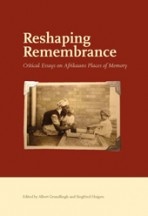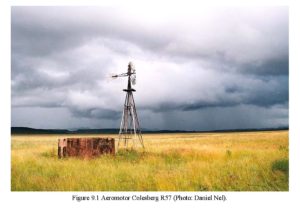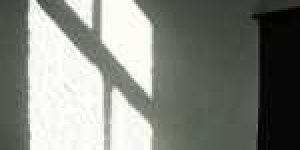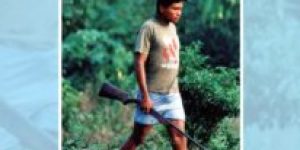Reshaping Remembrance ~ The Windpump
No Comments yet 1.
1.
Elbie Immelman[i] tells the story of Piet Olivier and his treacherous windpump in the South African newspaper Die Burger of 9 September 2000. His family had been farming on the Karoo farm Kweekwa in the vicinity of Victoria-West since 1853. Because the farm of 29 000 morgen (about 60 000 acres) was situated on the route between Victoria-West, Pampoenpoort, Carnarvon, Williston and Calvinia, it served as a point of call for the British patrols who had to feed their horses and take in fresh water supplies. Piet’s wife, Chrissie, managed to turn these stopovers to account, however. Whenever she saw dust rising from the transport road, she started to bake bread with the flour she kept hidden in an old well near their house.
When windpumps were introduced into South Africa, Piet Olivier was one of the two farmers in the Victoria-West district who acquired one. He was quite prosperous – he had 204 horses, which the British all commandeered, down to the last cart and saddle horse. To demonstrate their benevolence they allowed him to keep all of four donkeys for his own use, of course with the stipulation that he was not to tend to them or stable them.
But that was not the end of the British soldiers’ generous treatment of the farmer. One day the British raised the dust on the transport road to serve a summons on Oom Piet. The charge: spying. He had been sending secret messages with a heliograph. Although he was taken aback (he did not own a heliograph), he was not going to take this lying down. When a deputation of the Mounted Troopers arrived to escort him to town, he put his foot down and refused to go with these South Africans who had joined the British forces. The British and none but the British were to escort him. The Troopers returned to town tail between the legs, and delivered Oom Piet’s message to the Sixth Inniskillin Dragoons, who had been stationed on the edge of the mountain to the south of Victoria-West since the Northern Cape farmers had rebelled.
Eleven Dragoons duly set off to Kweekwa and ordered Oom Piet to walk to the town. It being beneath his dignity to walk for 40 km while the hated British soldiers were on horseback, Oom Piet once again refused: the Troopers had to organise transport for him. They had not reckoned with Oom Piet’s obstinacy, of course, and so they had to stay the night on the farm, Tant Chrissie having to serve them. The second day on the farm came and went, and on the third day an obdurate Oom Piet suggested they fetch his foreman Hugh Wilson’s cart from Witkranz. If two Troopers were to put their horses before the cart, they could ride in it to town, together with Oom Piet… What the tight-lipped Englishmen had to say to each other and to Oom Piet while they were together in the cart is best left to the imagination; it is enough to say that they took Oom Piet’s advice and temporarily locked him up in town. Later, he was freed on parole but had to while away the time in his tuishuis (a small house in which farmers stayed during infrequent visits to town) in Pastorie Street with his family, reporting to the British twice a day. After the war Oom Piet went back to his farm. One evening he was standing on the porch when he noticed a flashing light. When he and Tant Chrissie investigated, they found out that it was caused by the windpump’s steel blades reflecting the moonlight. And so they discovered a possible source of the so-called heliograph messages. Or so the story goes.
There is irony hidden in this story: the windpump, iconographically drawn on the Afrikaner landscape of the late nineteenth and early twentieth century as the source of a steady water supply and hence of survival, as passport to expansion, is here the treacherous element leading to the internment of the Boer and his restriction to a tuishuis in Pastorie Street.
In this essay, I intend to throw some light on the ironies inherent to the establishment of the windpump as site of collective memories, to trace the way in which these memories are embodied in the form of a museum initiated and managed by the community, and lastly to ask how this embodiment should be interpreted within the current discourse on sites of shared memory.
2.
The irony in this story about the Anglo-Boer War proves to be a recurring motif in the establishing of technological innovations in the Western Cape landscape. Sean Archer[ii] points out that there is evidence in both the Descriptive Handbook of the Cape Colony and the Blue Book 1875 (respectively published in 1875 and 1876) indicating that windpumps were a part of the Karoo landscape by the last quarter of the nineteenth century. The first windpumps were not, however, truly South African. Archer points out that the origin of these windpumps is not clear, but that an imported American Halliday Standard had been erected in Hopetown by 1874.[iii]The South African landscape soon had quite a cosmopolitan population of techno-immigrants: besides the wooden Halliday Standard and Manvel there were the Aermotor, Atlas, Atlas Ace, Baker Runin-Oil, Dandy, Defiance Oilomatic, Dempster Annu-oiled, the Steel Eclipse, Eclipse Model 45, Gypsy Wonder, Mogul, Perkens Triple Gear, Samson, Star and Star Zephyr from the USA; the Adler (later Conquest) and Holler from Germany; the Massey Harris, Beaty Pumper and Imperial from Canada; the Climax and Hercules from England and the Southern Cross from Australia.[iv] Nearly as colourful as the melting pot from which the owners of the farms originated…
The first windpumps were made in South Africa at the beginning of the Second World War when it was proving impossible to import them.[v] Up to that date the South African market had been dominated by the American manufacturers who supplied as much as 80% of all windpumps in the country. By 1942, however, Stewarts and Lloyds were manufacturing Climax windpumps in Vereeniging. South African production was getting in stride.[vi]
Although the British windpump was manufactured under licence from Thomas and Son in South Africa, its design was adapted several times and even changed because of information gleaned from the Weather Buro’s 1956 publication Surface Winds of South Africa.[vii] The average wind speed in South Africa was calculated at 7,3 miles per hour and in 1957 the construction of the wheel and tail was adapted for maximum effectiveness at a lower as well as initial wind speed of seven miles per hour.[viii] This windpump, the first truly South African one, sold well. Walton quotes Frank Mangold who, in 1957, claimed that about 12 000 windpumps were sold annually and that probably 97,5% of these were manufactured in South Africa. The most popular windpump was the Climax, the South African version of the British windpump. Besides the Climax there were Gearing, M&S Rotor, Malcomess-Buffalo Double Geared Oil Bath, President, Southern Cross and Springbok windpumps – some with patriotically resonating names.[ix]
One of these, the Malcomess, gained tongue-in-cheek parliamentary recognition when the then Minister of Agriculture, Hendrik Schoeman, christened Mr John Malcomess, Progressive Federal Party MP for Central Port Elizabeth, ‘Windpump’.[x] The Springbok was advertised with pseudo-ecologic appeal as ‘Friends of the Veldt’[xi], with seven small springbuck grazing on open, rather barren Karoo veldt dwarfed by a gigantic steel windpump, inadvertently emphasising the reality of overgrazing that was one of the unforeseen results of the advent of the windpump. The windpump as site of Afrikaner memories came to life in one of only two windpump museums in the world: the Fred Turner Museum in Loeriesfontein (the other being in Batavia, Illinois).
The impetus for establishing a windpump museum on the site of the Fred Turner Museum[xii] in Loeriesfontein is another exotic thread in the story of the windpump. The windpump museum was the culmination of the 1996 interaction between readers of the Woongids (later WoonBurger) supplement to Die Burger and James Walton, a migrant from Yorkshire who had emigrated to Lesotho in 1947 where he had been appointed Deputy Director of Education.[xiii] After his retirement in 1960, he became the managing director of the publishing company Longmans South Africa in Cape Town, and also kept himself busy with one of his lifelong interests, vernacular architecture.[xiv] According to Van Bart, Walton was a scholar of world renown in this field. Most of his publications about vernacular architecture in Africa, Europe and the Far East were pioneering works. The University of Natal awarded him an honorary degree in Architecture for his contribution to South African vernacular architecture, and he received a medal of honour from the Genootskap vir Afrikaanse Volkskunde (Society of Afrikaans Folklore) of the University of Stellenbosch. Walton was a founding member and lifelong honorary president of the South African Vernacular Architecture Society and, in July 1999, its VASSA Journal devoted its entire first edition to his culturehistorical contribution.[xv]
Walton’s interest in windpumps began when he commented on Woongids articles about the restoration of three windmills in Cape Town: De Nieuwe Molen, Mostert se Meul and Onze Molen (The New Mill, Mostert’s Mill and Our Mill).[xvi] André Pretorius remembers the eighty-five year old cultural historian saying that large parts of the interior of South Africa would never have been amenable to agriculture were it not for the contribution of the windpump, and that the history of the development of these regions should be documented. Although he had no first-hand knowledge of it, he immediately began to do research on the subject, corresponding with local and American windpump manufacturers about technical information. Pretorius assisted by taking photos.[xvii]
Walton then decided to write a series of articles about windpumps for the WoonBurger. The unprecedented reactions from readers led to some more articles, culminating in the publication of the first book on the subject, Windpumps in South Africa.[xviii] The enthusiastic participation by readers of the newspaper shows that South Africans took an active part in creating memories, and memories as ‘memory experiences’, a term coined by Mary Warnock.[xix] This was a democratisation of both history content and history practice that was not orchestrated by academics [and was for that very reason successful – see for instance the attempt to democratise history in the USA in the seventies and eighties that did not always succeed because it was hijacked by academics who could not get rid of their ‘habits of professionalization’].[xx]
According to Van Bart, the entire edition of 500 copies of Windpumps in South Africa was sold, and he stresses that Walton wanted the book to be translated into Afrikaans for the rural Afrikaans people, something that unfortunately did not happen.[xxi] There is food for thought here: it was a native of Yorkshire who committed this Afrikaner memory site to paper, and the resulting book was available only in English. The people of Loeriesfontein, who established the museum, did so in reaction to Walton’s appeal in the WoonBurger to the farming community to establish a windpump museum.[xxii] For the community of Loeriesfontein, which in 2000 had about 2.000 inhabitants, the museum was an opportunity to bring their town to the attention of tourists. The inhabitants, and specifically the Board of Trustees of the museum and the participants in the project Aksie Windpompe (a group of enthusiastic community members), had as goal the preservation of some of the more interesting windpumps.[xxiii]
Aksie Windpompe turned the museum into a space where the idea of ‘shared authority’ could be realised. It is an example of the ‘dialogue driven’ museum to which Rosenzweig and Thelen refer in their work.[xxiv] In the context of a dialogue driven museum the ‘neglected history’ is reclaimed ‘in tandem with the people the history is about’ so that ‘personal memory and testimony inform and are informed by historical context and scholarship’.[xxv] The museum project was also enthusiastically supported by farmers and townspeople who helped to find and even to transport windpumps. Donors’ and sponsors’ names were put on plaques at the windpumps.[xxvi]
According to the WoonBurger[xxvii] six restored windpumps had been erected by September 1997 – and all had been donated. By 1998 there were twelve,[xxviii] and a year later seventeen.[xxix] When Attie Gerber made a television programme for the South African Broadcasting Company (SABC) about the museum in 2000, the number of windpumps had grown to twenty. By 2001 even overseas specialist magazines such as the Windmillers Gazette, published in Rio Vista, Texas, praised the museum for its 21 acquisitions.[xxx]
The significant role of the windpump museum is highlighted in the text of the television production: ‘When you visit the twenty windpumps currently in the Fred Turner Museum in Loeriesfontein, the anonymous pump standing in lonely splendour in the veldt gains new meaning.’[xxxi] Each windpump’s small history of ‘prosperity and progress, of hardship and decay’ is laden with nostalgia and/or pathos.[xxxii] For instance, George Farmer, a veteran windpump specialist who erects the windpumps at the museum, told the television production team how he had lost a finger while servicing the head of a windpump. Nevertheless he had continued with this trade – at the time when the programme was filmed for more than thirty years – for servicing and repairing windpumps is the trade he learnt from his father and teaches his sons, regardless of the dangers it may involve.
The collection of windpumps should, however, not be seen in isolation. Visitors to the museum can also look at a display illustrating the lifestyle of the trekboer (nomadic grazier) of yore. There are artefacts from that era, including a horse mill, a trek wagon and a handmade tent used by sheep farmers, while the peddler and Bible distribution wagon owned by the pioneer Fred Turner also forms part of the collection. Visitors can even order typical Bushmanland dishes such as freshly baked salt-rising bread and juicy mutton to be prepared in the traditional asbosskerm (shelter made with lye bushes) with its clay ovens[xxxiii] and in this way participate in the cultural legacy of the trekboere. The windpump is presented within the context of the museum collection in its entirety as technology which made further colonial expansion and settlement possible and also supported it.
The windpump is not, however, the only technology that gave access to water commemorated by the museum. In due course the drilling machine, inevitably a part of the windpump industry, also made its appearance at the museum. My personal bond with water technology comes via the borehole culture, as my grandfather on my mother’s side, his son and grandson were all involved in it (even to the extent of having an inherited metal spring divining stick). Some of my earliest memories are about my mother telling me stories about her childhood, stories that were imbedded in a nomadic existence in caravans, moving from borehole to borehole as my grandfather paved the way for ever more windpumps, at first with a percussion drill and later with a combination drill. I remember being impressed by my grandmother’s resourcefulness in maintaining a neat, clean and hospitable home despite restricted means and facilities. In addition to being a driller, my grandfather Chris was also a water diviner. When a drilling project was not successful he would exempt farmers from financial obligations for boreholes he had guaranteed would produce water. According to my mother, he was quite successful with his metal spring divining stick in drilling projects in the Northern Cape, but she also remembers that he was less successful in Namibia as he did not know that area very well.[xxxiv] He continued with this pastime even after his retirement from drilling boreholes.
Boreholes as reference point for emotional landmarks, or ‘distinctive emotional lifeevents that associate external landmarks with autobiography, thereby forming internal reference points’,[xxxv] are not, however, as imposing as the iconic windpump and as far as I know no written account of the South African borehole / percussion drill culture exists. The only storage and conservation space which commemorates it is the Fred Turner Museum. In 2001, the museum received a valuable donation from ‘a son of Loeriesfontein’, Bertie Hoon: an old-fashioned percussion drill machine mounted on a truck of similar age. It is a remarkable donation when one considers the trouble that was taken to transport the machine from the farm Paddaputs, 35 km from Aus in the district of Karasburg in Namibia, to Loeriesfontein, a distance of 800 km. Fifty years before this event the Keystone drill and Chevrolet truck, at that time the property of Mr De Mann, had become stuck in the sand dunes where it had stayed half buried in the sand until it could be towed to a loading area. The goodwill with which one Mr Koos Kearney made his truck available, the way the chairman of the agricultural co-op, Floors Brand, co-ordinated the process and organised volunteers, and the determination of the said volunteers attest the importance for the community of preserving water technology as collective memory site.[xxxvi]
3.
The motivation of the Afrikaner to take so much trouble to establish and preserve a locus of Afrikaner memory will bear reflection; however, I would like to pose the question whether this intentional ‘participating creation of history’ is part of a broader discourse on memory experiences occurring after 1994.
An increasing awareness that the rainbow nation was not being realised brought the question of restitution more and more to the foreground. The Truth and Reconciliation Commission (TRC), especially, emphasised the idea of various forms of restitution. Land reform and financial reparation are the most relevant but by no means the only mechanisms of restitution suggested and implemented after 1994. Symbolic reparation occurred in the arts and in the rewriting of history. According to the TRC symbolic reparation refers to the mechanisms facilitating the communal process of remembering and commemorating the pain and triumphs of the past. The aim of symbolic reparation is to restore the honour of victims and survivors and includes excavations, gravestones, memorials, monuments and name changes of streets and public facilities. According to the TRC, reparations should also be seen as a national project and multifaceted process.[xxxvii] After the institutionalisation of the democratic government, symbolic reparation was made possible by the redistribution of resources as part of the transformation of institutions such as museums. This transformation also occurred under pressure from the state and previously marginalised communities.[xxxviii]
In ‘Post-apartheid public art in Cape Town: symbolic reparations and public space’ Zayd Minty highlights various symbolic reparation projects such as the District Six Museum, which has become a successful model of a community museum since 1994.
The museum examines the history, heritage, changed landscape and socio-economic changes of District Six in Cape Town through the memories of its former residents. These elements are all brought to play in the healing and transformation of the city.[xxxix] The methodology that Minty attributes to the District Six Museum is typical of participatory history writing: oral histories, creating spaces where dialogue can take place, interactiveness, community participation, co-authorship and the use of tangible forms. Another symbolic reparation project, Please Turn Over (PTO), undertaken in 1999 by Public Eye (a non-profit collective of artist-curators creating public art projects), appropriated monuments via ‘interventions’ which could be removed quickly. For instance, on 23 September 1999 Beezy Baily transformed a statue of Louis Botha into an abakhweta or Xhosa initiate coming home after his circumcision.[xl] Project Y350 was launched in 2002 and is based on research by Leslie Witz on the way racial identity was constructed in South Africa and the way white supremacy was strengthened by the Van Riebeeck celebrations in 1952. The project took the form of a conference on commemorative practices, displays about the Van Riebeeck celebrations and a public art intervention commemorating resistance to the celebrations.
Symbolic reparation included a wide spectrum of interventions which documented marginalised histories and re-contextualised existing areas of memory. It especially challenged fossilised and established memories and memory sites. Within this context of questioning, rewriting and documenting together with a redeployment of resources to archiving bodies, the conceptualisation of the windpump museum and its implementation as part of a colonial installation come as a surprise. It does have points of contact with the District Six Museum – as documentation facility and culmination of community directed methodologies – but where does the museum as memory site position itself vis-à-vis symbolic reparation? A more inclusive approach that gives recognition to other historical perspectives on the windpump and does not focus exclusively on the pioneer and his descendants would be more in keeping with the present discourse on symbolic reparation.
Memories are often the method of presentation in Afrikaans literature, and a good example of symbolic reparation of space as theme of a novel is Etienne van Heerden’s Toorberg.[xli] A decision has to be made around the borehole about Druppeltjie du Pisanie’s fate. The Moolmans make a unanimous decision, and Druppeltjie’s tragic death is the first family decision in which the Skaamfamilie (family of shame) and the other Moolmans participate together. Framed within Kaatjie Danster’s memories this story, in which water is an obvious theme, is illuminated from more than one perspective.
Water technology as memory site seems to be multifaceted in Afrikaner memory – sometimes an area marked by exclusivity and pioneer narrative, and sometimes marked by irony. By the end of the twentieth century water technology in literature has become an area of symbolic reparation and inclusivity, but the question remains whether the museum as institute of memory will follow in the footsteps of authors.
NOTES
i. Die Burger, 9 September 2000.
ii. S. Archer, ‘Technology and ecology in the Karoo: a century of windmills, wire and changing farm practice’, in: Journal of South African Studies, 26 (2000) 681.
iii. Ibid., 681-682.
iv. J. Walton & A. Pretorius, Windpumps in South Africa. Wherever you go, you see them: whenever you see them, they go. Cape Town: Human & Rousseau 1998.
v. J. Walton & A. Pretorius, Windpumps in South Africa. Wherever you go, you see them: whenever you see them, they go. Cape Town: Human & Rousseau 1998, 58.
vi. S. Archer, ‘Technology and ecology in the Karoo: a century of windmills, wire and changing farm practice’, in: Journal of South African Studies, 26 (4), 2000, 683.
vii. J. Walton & A. Pretorius, Windpumps in South Africa. Wherever you go, you see them: whenever you see them, they go. Cape Town: Human & Rousseau 1998, 58.
viii. Ibid., 58-59.
ix. Ibid., 62, 66, 68, 69, 71, 72.
x. Die Burger 26 April 1986, 11.
xi. J. Walton & A. Pretorius, Windpumps in South Africa. Wherever you go, you see them: whenever you see them, they go. Cape Town: Human & Rousseau 1998, 73.
xii. In the 1970’s the site of the Fred Turner Museum and the erstwhile school were donated to the Municipality of Loeriesfontein so that an agricultural museum could be established. The site was later also used to house the windpump museum.
xiii. P. Oberholster, ‘Reminiscences of the early days in the study of South African vernacular architecture’, in: VASSA Journal, 1 July 1999, 5.
xiv. M. van Bart, ‘Yorkshireman het Suid-Afrikaners geleer hoe om te bewaar’, VASSA Journal, 1 July 1999, 9-12.
xv. Editor’s foreword, VASSA Journal, 1 July 1999, 3.
xvi. M. van Bart, ‘Yorkshireman het Suid-Afrikaners geleer hoe om te bewaar’, VASSA Journal, 1 July 1999, 11.
xvii. A. Pretorius, ‘A belated friendship’, in: VASSA Journal, 1 July 1999, 17.
xviii. J. Walton & A. Pretorius, Windpumps in South Africa. Wherever you go, you see them: whenever you see them, they go. Cape Town: Human & Rousseau 1998.
xix. S. Crane, ‘Introduction Museums and memory’, in: S. Crane (ed.). Museums and memory. Stanford, Calif.: Stanford University Press 2000, 2.
xx. R. Rosenzweig & D. Thelen, The presence of the past. Popular uses of history in American life. New York: Columbia University Press 1998, 4.
xxi. M. van Bart, ‘Yorkshireman het Suid-Afrikaners geleer hoe om te bewaar’, VASSA Journal, 1 July 1999, 11.
xxii. Ibid., 12.
xxiii. Die Burger, 22 July 2000, 4.
xxiv. R. Rosenzweig & D. Thelen, The presence of the past. Popular uses of history in American life. New York: Columbia University Press 1998, 182.
xxv. Kuo Wei Tchen, quoted in R. Rosenzweig & D. Thelen, The presence of the past. Popular uses of history in American life. New York: Columbia University Press 1998, 182.
xxvi. Die Burger, 22 July 2000, 4.
xxvii. Ibid.
xxviii. A. Pretorius, ‘Skaars windpomp van Rûens na Boesmanland’, in: Die Burger, 8 Augustus 1998, 2.
xxix. A. Pretorius, ‘A belated friendship’, in: VASSA Journal, 1 July 1999, 17-18.
xxx. Die Burger, 3 March 2001.
xxxi. A. Gerber (director), As die wind waai. Television production for SABC2 broadcast on Sunday, 6 August 2000.
xxxii. I use Reinhold Niebuhr’s definition of pathos: ‘Pathos is that element in an historic situation which elicits pity, but neither deserves admiration nor warrants contrition. Pathos arises from fortuitous cross-purposes and confusions in life for which no reason can be given, or guilt ascribed. Suffering caused by purely natural evil is the clearest instance of the purely pathetic’. R. Niebuhr, ‘Preface’, in: R. Niebuhr. The irony of American history. London: Nisbet & Co. 1952, ix.
xxxiii. Die Burger, 22 July 2000, 4.
xxxiv. S.E.J. Bakker and A. Bakker, Personal interview, Somerset-West, September 2007.
xxxv. Oakley quoted in G. Gartner, PowerPoint presentation about emotional landmarks. Presented at GeoGeras, Vienna, 2005.
xxxvi. Die Burger, 3 March 2001.
xxxvii. Z. Minty, ‘Post-apartheid public art in Cape Town: Symbolic reparations and public space’, in: Urban Studies, 43 (2) 2006, 423.
xxxviii. Ibid., 425
xxxix. Z. Minty, ‘Post-apartheid public art in Cape Town: Symbolic reparations and public space’, in: Urban Studies, 43 (2) 2006, 427-428.
xl. Ibid., 432.
xli. E. van Heerden, Toorberg. Cape Town: Tafelberg 1986.
References
Archer, S. ‘Technology and ecology in the Karoo: a century of windmills, wire and changing farm practice’, in: Journal of Southern African Studies, 26 (4) 2000, 675-696.
Bakker, S.E.J. and Bakker, A. Personal interview. September 2007.
Crane, S. ‘Introduction Museums and memory’, in: S. Crane (ed.). Museums and memory. Stanford, Calif.: Stanford University Press 2000, 1-13.
Editorial comment. VASSA (Vernacular Architecture Society of South Africa) Journal, 1 July 1999, 3-4.
Gartner, G. ‘Power Point presentation on emotional landmarks.’ Delivered at GeoGeras, Vienna 2005.
Gerber, A. (director). As die wind waai. Television production for SABC2, shown on Sunday, 6 August 2000.
Immelman, E. ‘Windpompwieke “sein” ‘geheime boodskappe’ aan Boere’, in: Die Burger, 9 September 2000.
Leer Boesmanland ken deur Loeriesfontein se museum. Die Burger, 22 July 2000, 4.
Minty, Z. ‘Post-apartheid public art in Cape Town: symbolic reparations and public space’, in: Urban Studies, 43 (2) 2006, 421-440.
Niebuhr, R. ‘Preface’, in: R. Niebuhr. The irony of American history. London: Nisbet & Co. 1952, ix-xi.
Oberholster, P. ‘Reminiscences of the early days in the study of South African vernacular architecture’, in: VASSA Journal, 1 July 1999, 5-8.
Ou boormasjien uit Namib vir Loeriesfonteinse museum. Die Burger, 3 March 2001.
Pretorius, A. ‘A belated friendship’, VASSA Journal, 1 July 1999, 15-19.
Pretorius, A. ‘Skaars windpomp van Rûens na Boesmanland’, Die Burger, 8 August 1998, 2.
Rosenzweig, R. and Thelen, D. The presence of the past. Popular uses of history in American life. New York: Columbia University Press 1998.
Swart, F. ‘Indrukke uit die parlement: In landbou kou ministers harde bene’, in: Die Burger, 26 April 1986, 11.
Van Bart, M. ‘Yorkshireman het Suid-Afrikaners geleer hoe om te bewaar’, in: VASSA Journal, 1 July 1999, 9-12.
Walton, J. and Pretorius, A. Windpumps in South Africa. Wherever you go, you see them: whenever you see them, they go. Cape Town: Human & Rousseau 1998.
You May Also Like
Comments
Leave a Reply






